|
|
This article acts as a guide to the Docman Hub system.
To navigate the topics, use the Table of Contents on the left.
The Hub console provides access to the configuration options and statistics related to Hub transmissions. To access the Hub console, take the URL of the Hub and add "/edtweb" to the end.

The Hub console login screen opens. Enter the login supplied to you by your Hub administrator and press login.

Once you press Login, the Hub Activity Summary screen opens.
Upon logging into the Docman Hub console, you are presented with the Activity Summary screen. This screen displays the Hub document count, both overall and split into several categories.

The options pane on the left allows you to view and configure the Hub.
|
The access log maintains a record of all login and logout activities. In the screenshot below you can see the dates and times that the ADMIN user logs in and out. Additional information such as the name of the Docman Hub machine and the IP address of the PC the user is logging in from are also displayed. |
|
|
|
To the right there is a View/Edit icon |
|
|
|
Click on the Back button to return to the Access Log.
The Access Log will only display 30 lines of information. |
|
|
|
To view older/newer details you can navigate using the Next and Previous buttons at the bottom of the list. If one of these buttons is greyed out it means you are at the beginning or end of the list. |
|
The document list will display a list of documents stored on the Docman Hub. The documents are displayed in date order with the most recent at the top. It is possible for you to apply filters to change the way in which documents are displayed. |
||||||||||||
|
|
||||||||||||
|
Colour is used in the list to provide a visual method of seeing the status of the documents. The table below provides a key to the colour coding in the document list.
|
|
The Document List will only display up to 30 lines of information. To view older/newer details you can navigate using the Next and Previous buttons at the bottom of the list as shown in the screen shot below. |
|
|
|
If one of these buttons is greyed out it means you are at the beginning or end of the list. |
|
The filter panel allows you to reduce the number of documents you can see in the list by only displaying documents which match your filters. |
|
|
If you are looking for a document from Biochemistry for a patient with the surname of Jones you can set your filters as shown below:

When you select a filter setting from the dropdown lists, the Document List will automatically update. However, when you add text to the filter settings on the right you will need to press Enter to cause the Document List to update.
In the example above we pressed Enter to make the document list update on the screen.
To View/Edit a document, click on the View/Edit  icon located in the far right hand column of the Document List.
icon located in the far right hand column of the Document List.

In the document details you will be able to see when the document was added, the status of the document, where it comes from and where it is going to. Unlike older versions of Hub, there is no Save button at the bottom of the document details; changes are saved automatically.
The options alongside Change Status change depending on the current status of the document. Documents that have been rejected give a rejection reason, and the option to Delete or Resend. Notes stored with a document may also be updated by typing in the Doc Notes field and clicking Update Notes.
Rejected documents are documents that were transmitted to an End Point, but rejected and sent back to the Hub. Rejections may take place on the Hub (Rejected by System) or at the End Point (Rejected by Receiver).
An End Point may have one of a variety of reasons to reject a document, and they are prompted to provide the rejection reason when running through the document rejection process. This reason is displayed along with the document details so that the hub may process the rejected document and take appropriate action.

Potential rejection reasons from an End Point are as follows:
| Rejection Code | Rejection Reason | Description | Suggested Action |
|---|---|---|---|
| REJ01 | Patient is no longer registered at this practice | Patient was registered at the End Point, but has since moved to another. | Re-check the patient and End Point details and re-send to the correct End Point. |
| REJ02 | Patient never registered at this practice | Patient has never been registered at this End Point. | Re-check the patient and End Point details and re-send to the correct End Point. |
| REJ03 | Incomplete document | Transmitted document is missing information. | Re-check the document and recapture if necessary to provide missing information, then re-send. |
| REJ04 | Document cannot be viewed | Transmitted document is corrupt or not of legible quality. | Re-check the document and recapture if necessary to improve quality, then re-send. |
| REJ05 | Duplicate document already received | Document quality is appropriate, patient is registered at the End Point, but the document has already been received by the End Point. | Document does not need to be transmitted to the End Point again; delete. |
|
Warning: The Meta data is determined by the sender and cannot be changed. If you do attempt to make changes they will not be saved. If the information is incorrect the document should be rejected and the sender will need to resend the document with the correct information. |
|
Relayed Documents are documents that are sent to End Points on other Docman Hubs. There are times you may want to search the Relayed Documents; for example when a document does not reach its endpoint. This Relayed Documents screen will only display outbound documents; i.e. Documents being sent from your Docman Hub.
|
|
|
|
|
When you view the Relayed Documents screen you will be presented with a filter panel that will allow you to narrow your list according to filter settings. Click on the list box buttons to reveal a list of options to pick from or type the document reference directly in to the Doc Ref box. |
|
|
|
|
|
You can filter by the document status using the Status drop-down menu. |
|
|
|
|
|
Click on the View/Edit button on the right hand column of the document record to view the document details. |
|
If you have more than thirty relayed documents you can use the Previous and Next buttons to navigate the list. |
The Last Checked column displays the last time that the status of the document on the Relayed Hub was checked by the Local Hub. The status of each document is checked automatically on a regular interval, stopping when the document is older than a set number of days. This is set to 14 days by default, but can be changed in the Hub System Settings menu. Yellow warning triangles appear next to all documents that have not been checked in the last 24 hours. Documents can be checked manually by ticking the tickbox next to one or multiple documents and clicking Recheck Selected.


|
The transmission log shows each individual transmission in descending chronological order. Errors in transmission are indicated by displaying the record in red and appending a yellow warning triangle. |
|
|
|
|
This list will only display a maximum of thirty records. You can use the Prev and Next buttons at the bottom of the screen to navigate the list. |

The filter allows the user to limit which individual logs are shown at any given time. The filter is applied to all transmission logs stored on the Docman Hub to narrow down the view to the individual logs you are looking for.
As and when the filter is changed the transmission log will automatically reload, displaying logs matching your criteria only.

|
|
To view the detail contained in a transmission log, click on the
|
|
When you click on the View button the Transmission Detail screen will appear: |
|
|
|
Click on the Back button to return to the Transmission Log. |
|
This is a statistical reporting screen which provides you with information regarding document End Points. A filter panel is provided, allowing you to view the information in different ways. Click on the list box buttons in the filter panel to see the filter options. |
|
|
|
This screen presents statistics for the Docman Hub. You may set a filter for an individual Source or End Point. If you wish to include this information in a report or perform more complex analysis you can export to a CSV file and then open the file in Excel or Word. You can then analyse and present the information in different ways using Excel Pivot Tables or Excel Filters. |
Click on the Export to CSV button on the bottom right of the screen. You will see a message box asking if you want to open or save the file. If you are using Internet Explorer 9, you will see a message at the bottom of the browser window.

If you select Open, the data will open in an Excel Workbook, if you select Save the data will be saved for a CSV file which you will be able to open with Excel or import into Word as an Object.

This is a statistical reporting screen which provides you with information regarding document transmission. This shows you the numbers of documents collected and delivered for each End Point. A filter panel is provided, allowing you to view the information in different ways. Click on the list box buttons in the filter panel to see the filter options.

This screen presents statistics for the whole Docman Hub however; you can set a filter for an individual End Point on the Hub of for a date range. If you wish to include this information in a report or perform more complex analysis you can export to a CSV file and then open the file in Excel or Word. You can then analyse and present the information in different ways using Excel Pivot Tables or Excel Filters.
This list will only display a maximum of thirty records. Use the Prev and Next buttons to navigate the list.
Click on the Export to CSV button on the bottom right of the screen. You will see a message box asking if you want to open or save the file. If you are using Internet Explorer 9 you will see a message at the bottom of the browser window.

If you select Open, the data will open in an Excel Workbook, if you select Save, the data will be saved for a CSV file which you will be able to open with Excel or import into Word as an object.

The end point list displays all end points which are setup on the Docman Hub. Filters are provided to enable you to easily narrow your search for an End Point in the list.

This list will only display a maximum of thirty records. Use the Prev and Next buttons to navigate the list.
|
To add a new End Point to the Docman Hub, select End Points from the menu on the left hand side of the screen under the
The End Point List will be displayed. Scroll to the bottom of the list and click on the Add button.
The End Point Details screen will be displayed with the fields all blank ready for you to enter the details of the End Point. |
|
|
The End Point Name, Contact, Contact Email and NACS Code fields are compulsory and must be filled in before the new End point can be saved. Password and Confirm Password are also required.
Once the fields are filled in as required, click Save to create the new End Point.
To view/edit an end point, click on the View/Edit button  located in the far right hand column of the end point list. The End Point details screen will open and you will be able to see all of the details for the chosen End Point.
located in the far right hand column of the end point list. The End Point details screen will open and you will be able to see all of the details for the chosen End Point.
|
|
IP Security is an authentication method that stores a list of IP addresses. End Points connecting to the Hub through Scheduler are checked against this and allowed to connect based on their IP. Filters are provided in the panel at the top of the screen to allow you to easily locate a particular End Point.

To view/edit an IP security record, click on the View/Edit  button located in the far right hand column of the IP security list.
button located in the far right hand column of the IP security list.

The document source list displays a list of all document sources on the Docman Hub. A filter panel is provided to enable you to search for a Document Source more easily.

|
To configure a Document Source, select Document Sources from the menu on the left hand side of the screen under
The Document Source List will be displayed.
Scroll to the bottom of the list and click on the Add button.
The Document Source Details screen will be displayed with blank fields ready for you to enter the details.
|
|
Fields in the Document Source Details Screen● ID - Automatically-assigned ID number for the new source.
● Description - Free-text description of the new document source.
● Alert Email - Notifications regarding the document source are sent to the specified email address.
● Skip GMC Code Validation - Ticked by default. If unticked, the Hub will force a validation of the GMC codes before allowing documents to be added.
● Allow No ID - If this option is ticked, the Hub will allow documents to be added without a unique source reference ID. The Hub will generate an ID for documents added without this, but will prevent sites from back-tracing a document from the Hub.
● Inactive - Marking a document source as inactive prevents them from appearing as a valid source until the option is unticked. This allows document sources to be set up in advance and activated on a later date.
● Allow External Routing - If this is checked then the Docman Hub will allow documents to be sent to a remote Docman Hub, provided there is a sharing agreement between the two Hubs.
● Chargeable - If this option is checked then this Hub will receive a charge for sending the document to the remote Hub; it is not applicable to local Hubs. Charges for document transmission are applied according to the agreed contract between Docman and the Healthcare Trust running the Hub. By default, this option is checked on new sources.
● Document Conversion Format - This option determines whether documents that arrive at the Hub in formats other than TIFF are to be converted to TIFF format. Selecting this option will flag non TIFF format documents as “Conversion Pending”.
● Add font to HTM/HTML Source - Some documents that are posted to Docman Hub use the HTML format that contains a PRE tag. This tag causes problems with formatting on conversion to TIFF. Selection of this flag will remove the PRE tag and replace with an alternative HTML tag that will allow the correct formatting for the conversion.
● Post to Vault - This option allows documents to be posted to the Docman Vault. Tick "Post to Vault" to automatically post documents to Vault. |
To view or edit a document source, click on the View/Edit  button located in the far right hand column of the document source list.
button located in the far right hand column of the document source list.
The Document Source Details screen will be displayed and you will be able to see the configuration details for the Document Source in detail.

The User List displays a list of all the user accounts on the Docman Hub. Above the list is a filter that allows you to exclude inactive users. In the list you will be able to see the User ID, the user’s name, a description, their role and whether they are inactive or active. From the User List you can add new users and edit existing users.

The User List will only display 30 users per page. If your Docman Hub has more than 30 users you can use the Prev and Next buttons (displayed at the bottom of the list) to navigate through your users.

|
To add a Docman Hub Console user, click on the Add button at the bottom of the User List.
|
|
|
|
|
|
Add the required information into the fields in this screen. For help with this please see the information contained in the next sub section, Fields in the User Details Screen.
|
|
|
|
|
|
● ID - This will display the word NEW because you are setting up a new user. The ID number is not generated until you have finished entering information into this screen and have clicked on Save.
● User ID - This field can contain up to 10 characters which can be a mix of alpha and numeric characters. This is the ID the user will use to log in to Docman Hub.
● Role - The role can be selected from the drop down list. Roles can be viewed by clicking on Roles in the sidebar menu on the left of the screen.
● Description - The description can be up to 100 characters in length and can contain alphanumeric and punctuation characters.
● Password - You can add a password for your user here. Passwords can be up to 32 characters in length and should consist of alpha numeric characters. Passwords are not case sensitive.
● Confirm Password - Once you have added a password in the field above you need to retype it here to confirm it. If there is any difference between the two passwords you will be asked to enter them again when you try to save your new user details.
● Email - Add the user's email address into this field. This will enable them to request a reset of their password and access the NHS email system. The new user will now appear in your User List and will have a numerical ID assigned.
To View/Edit an individual user, click on the  graphic located in the far right hand column of the user list.
graphic located in the far right hand column of the user list.
When viewing a user, all of the fields are shown in much more details then what is shown in the user list.
This will open the User Details screen.

You can edit the user details and click on Save when you are finished.
When setting up a new user, you should associate them with a document source or a primary care facility. You will have a few users who do not require source assignment, such as Administrators.
You will need to have the User Details screen open. Click on the Assign Doc Source button on the bottom left of the screen.

This will open the Document Source List for the selected user.

Click on the  graphic to the right of a document source to open up the Details screen.
graphic to the right of a document source to open up the Details screen.
There is no document source selected in the example above because this is a new user (it could also be an administrator who needs to be able to see all documents).

Click in the "Assign to..." check box at the bottom of the details screen and click Save to assign this source to your user.
|
Note: You are able to edit the other fields on the screen but do this with care as you will be editing the information for all processes that utilise the document source information. |
When you have finished with this screen click Save.
You will be returned to the Document Source List for the user. You will now be able to see a check mark indicating that the source is assigned to the user.

If one of your users forgets their password you will need to perform a password reset. Open the User Details and click on the Reset Password link next to the Password field.

When you click on Reset Password you will see a message displayed requesting confirmation of the reset.

Click OK to continue with the reset. Once the Reset is complete you will be returned to the User Details screen. Under the details there will be a red message displayed. This tells you what the temporary password is and reminds you that the user will have to change this on their next login.
You should now let the user know what their temporary password is and warn them that they will need to change it next time they login.

(The temporary password is blanked out in the above image for security reasons)
The Roles screen allows you to set up new user roles and edit existing user roles.

Click on the Add button to add a new role.

Select Allow Document Source Assigning if you would like to be able to apply settings to individual users that allow them to only see documents from their own document source(s).
Provide a name and description for the role then click on the Save button.
This will add the new role to the list. You will not be able to set up the actual permissions until the role has been created.
When you have a newly created role or you wish to add or remove permissions for an existing role, you will need to edit the role.
On the right hand end of each role in the list is the View/Edit button  . Click the View/Edit button to open the Role Details screen.
. Click the View/Edit button to open the Role Details screen.

Click on the Page Permissions button to assign new or edit existing permissions for the selected role.
This page allows you to edit the permission levels for a particular group of users who are assigned to a role. To get to this page you will have clicked on page permissions while editing a particular role. If this is a new role all permissions will be disabled (indicated by a white cross on a red roundel).

To allow people (with the selected role) to have the ability to view, edit or delete, you need to click on the View/Edit icon  which is located on the right hand side of the page in the list.
which is located on the right hand side of the page in the list.

Select the permissions you wish to grant to people with the currently selected role by clicking on the check boxes. A check mark is displayed in the check box next to the permissions you are granting. Click the Save button to save your permissions.
After you have clicked Save you will be returned to the permissions list. A check mark appears to show the permission has been granted.

The system settings list will display all system settings on the Docman Hub.

The system settings list shows a maximum of 30 records by default. When the number of settings stored on the Docman Hub exceeds this number, you will be given the below navigation buttons along the bottom of the system settings list. These will allow the user to move back and forth through the pages of the system settings.

To view/edit a setting, click on the  graphic located in the far right hand column of the system settings list.
graphic located in the far right hand column of the system settings list.
When viewing a setting, all of the fields are shown in much more detail than what is shown in the system settings list.

Hub Administrators are now able to choose between showing the sender or the contributor for documents in the Documents List. This setting is in the System Settings section of the Hub.

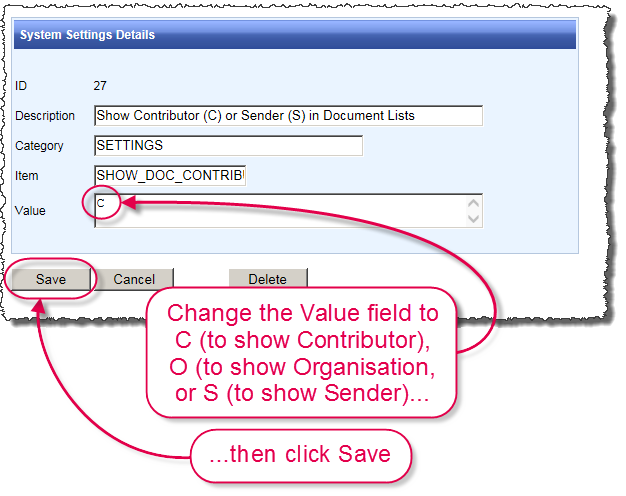
The Manage Sharing screen shows you a list of Docman Hubs you have a Sharing Agreement with. It is the Sharing Agreement that allows you to transfer documents with primary care facilities and secondary care facilities on other Docman Hubs.
To enable document transfer across Docman Hubs, Docman maintains a list of active Docman Hubs known as the Discovery Service. The purpose of the Discovery Service is to enable you to discover and invite other Docman Hubs to a Sharing Agreement. Once an invitation and acceptance has been processed all communication is then made directly between your Docman Hub and the Docman Hub you have the Sharing Agreement with. The Discovery Service merely enables you to establish contact and process invitations and acceptances.
| Note: The agreement will allow the web service of each Docman Hub to talk to each other, the physical network infrastructure (in particular the firewall rules at each end of the relationship) must be configured to allow it to happen. |
This Manage Sharing List displays a list of existing Sharing Agreements with other Docman Hubs. An example of the Manage Sharing List is shown below:

Like other lists in Docman Hub this list will only display a maximum of 30 Sharing Agreements. You can use the Prev and Next buttons to browse the full list. In the example screen above we only have two sharing agreements so the Prev and Next buttons are greyed out.
Click on the New Invite button. You will be taken to the New Sharing Request screen.

The drop down list contains the Discovery Service list of Docman Hubs. Select the Docman Hub you would like to send an invitation to.

|
Note: This list of Docman Hubs is derived from a test system and does not fully represent what you will see when you view the actual list. There will be many more Docman Hubs on the live system. |
Once you have selected the Docman Hub you would like to invite to a Sharing Agreement click on the Send Request button.
You will see a message asking you to confirm the sending of the request.

Click on the OK button to send the request.
You will be returned to the Manage Sharing List where you will be able to see your request.

Click on the View/Edit button on the right hand end of the row containing the invite you wish to cancel.

You will be taken to the Sharing Agreement Details screen where you can see the details of the invitation. Below the details is the Cancel Request button.

Click on the Cancel Request button. A message will appear requesting confirmation of the cancellation. Click on the OK button to proceed with the cancellation.
You will be returned to the Manage Sharing List. Your invite will no longer appear in the list.
At any point in time you can stop a sharing agreement.
| Warning: Care should be taken when doing this. If you stop a sharing agreement with a Docman Hub that has active document sources or end points you could potentially delay the delivery of hundreds of documents. |
Click on the View/Edit button on the right hand end of the Sharing Agreement you wish to stop.

The Sharing Agreement Details screen will be displayed.

Type a reason for stopping the agreement into the Stopped Reason field.

Click on the Stop Sharing button.
A message will appear requesting confirmation. Click on the OK button to confirm the stopping of the Sharing Agreement.
|
Note: If you fail to provide a reason you will not be allowed to proceed with this process. You will see a message appear stating that you need to specify a "stopped" reason. |

This process is similar to stopping a Sharing Agreement. You begin by clicking on the View/Edit button for the invitation you wish to reject. Then you type in a reason for rejecting the invitation and click on the Reject button.
If you fail to provide a reason you will not be able to proceed with the Rejection process.
Report Runner provides users with a system to run detailed reports on the Hub server.
To access the Report Runner, click the option on the left menu bar.


Each Report has a name and brief description of its function. Click on a Report name to view further details.
Filters can be applied by ticking one of the supplied filter options and filling in the parameters that appear.

Click Run Report to perform the report.

The report generates and appears; in this case, we see a single result based on the selected filters.
The results may be exported to a number of file formats using the Export function below the result list.

The service control manager has been replaced with an MVC application that contains all Hub configuration settings.
The maintenance service configuration may be accessed using the Configure Maintenance option, under the Configuration section of the Hub menu.

The maintenance configuration is split into three sections; Backup Configuration, E-Mailer Configuration and E-Mailer Scheduler.
The backup configuration allows the backup start time, location and log file location to be specified. The backup may also be configured to run on weekends, if required.
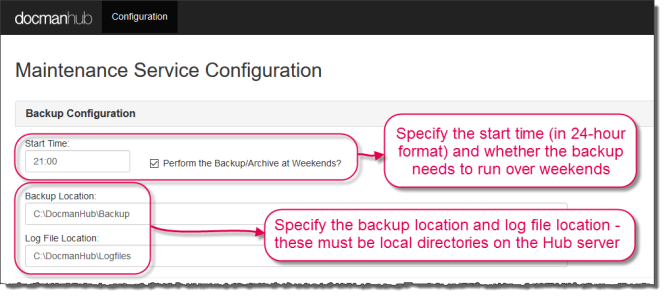
The Hub may be configured to send regular updates to the Hub Administrators. To do this, the Hub needs to be supplied with information on the SMTP server, authentication (if any is required) and address details.
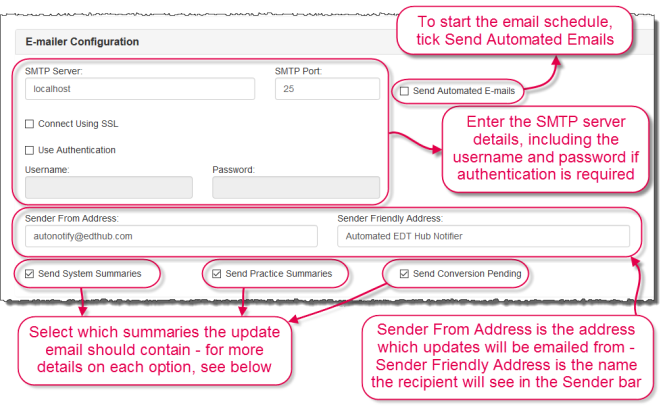
The E-Mailer Configuration lists three summary types which may be reported in the update email.
Send System Summaries sends an update on the Hub system itself, including the overall number of documents transmitted.
Send Practice Summaries sends an update on each practice's status, including the number of documents sent, received and accepted.
Send Conversion Pending sends an update on documents that are pending conversion. As the conversion process should be instant except in cases of problems with the TIFF Converter, a high number of documents pending conversion may be an early sign that Administrator attention is required on the Hub.
Once the e-mailer configuration is filled in, the scheduler information may be set up. This specifies the days and time(s) that the scheduled emails will be sent. The E-Mail Scheduler section is located below the Configuration section.
The update email contains information on documents that are pending conversion. As the conversion process should be instant except in cases of problems with the TIFF Converter, a high number of documents pending conversion may be an early sign that Administrator attention is required on the Hub. The settings of the pending document check may also be changed under the E-Mail Scheduler settings.
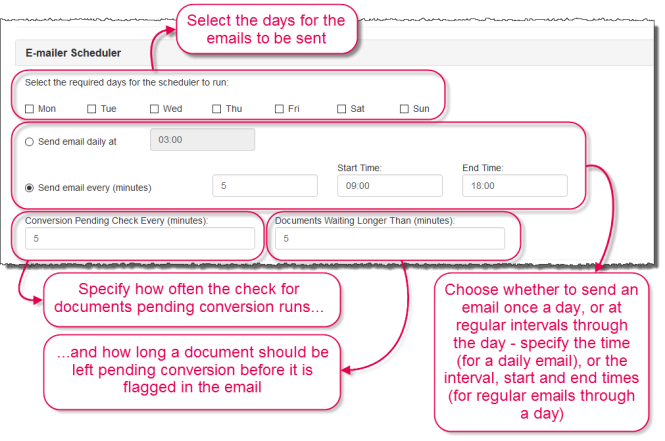
Hub documents, audits and metadata may be archived using the new Archiver tool. Users assigned to the System Administration group can configure archiving sessions, back data up to a chosen area and bulk-delete items using this tool.
Archiving removes delivered and deleted documents from the live Hub, reducing database and file store size and helping to maintain the efficiency of the system. The archive also runs as a backup, allowing data to be securely stored according to the Hub Administrators’ regulations.This replaces the retention policy on the Hub. Database size can only be reduced by using this functionality.
The Archiver may be accessed using the Archive Console option, under the Configuration section of the Hub menu.
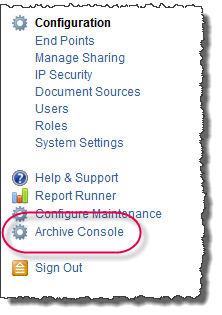

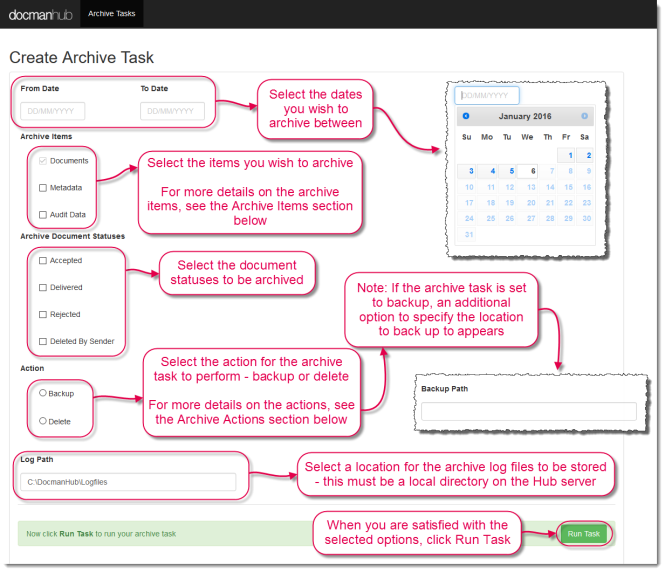
Three options are available for archive.
Documents refers to the actual document files. When backed up, these are placed in the chosen location in their original formats.
Metadata refers to the data attached to the document - patient details, date of encounter, organisation/department.
Audit Data refers to the audit data for the document - date and time of upload, identity of user that uploaded the document.
The documents tickbox is pre-selected and mandatory. Any combination of metadata and audit data may be archived.
One of two options may be selected for the action that the archive performs.
Backup backs the chosen documents up in their original formats to the user-specified location. Metadata and audit data, if selected, is saved in .xls format.
If backup is chosen, a second text field appears for a backup path. This must be an existing directory local to the Hub server.
Delete deletes the chosen files from the Hub.
| Warning: The Delete action will permenantly delete the chosen files from the Hub. |
|
Please Note: If the Rejected document status is selected for archiving, only the user-rejected documents will be archived. System-rejected documents are not archived, and should be investigated so they are successfully transmitted to the practice.
Additionally, documents with the status Accepted which are expected to be posted to the Vault will not be archived until they are sent to the Vault. Accepted documents which are posted to Vault, or which are from a document source where Vault is not enabled, will be archived as normal. |
|
Follow Docman! |
|
|
Docman is the trading name of PCTI Solutions Ltd. Pioneer Court, Pioneer Way Whitwood, Castleford WF10 5QU © 2000-2015 PCTI Solutions Ltd. Docman is the trading name of PCTI Solutions Limited, a company registered in England, company number 3342552 and registered address Pioneer Court, Pioneer Way, Castleford, WF10 5QU. VAT Registration No: 698853945. |